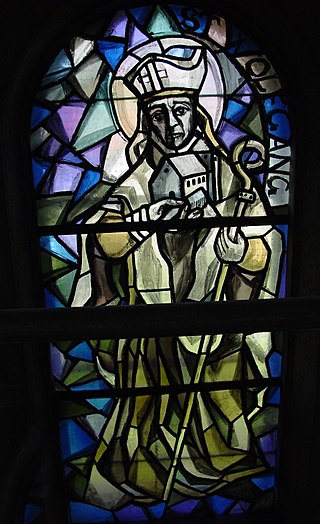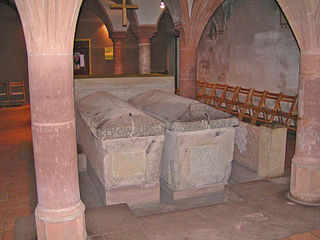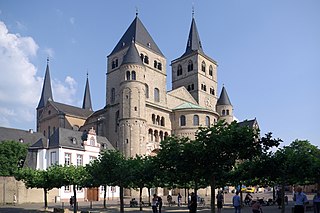
Trier, formerly known in English as Trèves and Triers, is a city on the banks of the Moselle in Germany. It lies in a valley between low vine-covered hills of red sandstone in the west of the state of Rhineland-Palatinate, near the border with Luxembourg and within the important Moselle wine region.

Willibrord was an Anglo-Saxon missionary and saint, known as the "Apostle to the Frisians" in the modern Netherlands. He became the first bishop of Utrecht and died at Echternach, Luxembourg.

Saint Wolfgang of Regensburg was bishop of Regensburg in Bavaria from Christmas 972 until his death. He is a saint of the Catholic and Eastern Orthodox churches. He is regarded as one of the three great German saints of the 10th century, the other two being Saint Ulrich of Augsburg and Saint Conrad of Constance. Towards the end of his life Wolfgang withdrew as a hermit to a solitary spot, in the Salzkammergut region of Upper Austria. Soon after Wolfgang's death many churches chose him as their patron saint, and various towns were named after him.

The Diocese of Mainz, historically known in English as Mentz as well as by its French name Mayence, is a Latin Church ecclesiastical territory or diocese of the Catholic Church in Germany. It was founded in 304, promoted in 780 to Metropolitan Archbishopric of Mainz and demoted back in 1802 to bishopric. The diocese is suffragan diocese in the ecclesiastical province of the metropolitan Archdiocese of Freiburg. Its district is located in the states of Rhineland-Palatinate and Hesse. The seat of the diocese is in Mainz at the Cathedral dedicated to Saints Martin and Stephen.

Maternus, also known as Maternus II, was the first known bishop of Cologne, reportedly also the third bishop of Trier, and founder of the diocese of Tongeren. He is venerated as a saint in the Catholic and Eastern Orthodox churches. The Basilica of Saint Maternus in Walcourt, Belgium was allegedly founded by him.
Jonas of Bobbio was a Columbanian monk and a major Latin monastic author of hagiography. His Life of Saint Columbanus is "one of the most influential works of early medieval hagiography."

Anglo-Saxon missionaries were instrumental in the spread of Christianity in the Frankish Empire during the 8th century, continuing the work of Hiberno-Scottish missionaries which had been spreading Celtic Christianity across the Frankish Empire as well as in Scotland and Anglo-Saxon England itself during the 6th century. Both Ecgberht of Ripon and Ecgbert of York were instrumental in the Anglo-Saxon mission. The first organized the early missionary efforts of Wihtberht, Willibrord, and others; while many of the later missioners made their early studies at York.

Saint Valerius of Treves (†320) was a semi-legendary Bishop of Trier. His feast day is 29 January.

The Abbey of Echternach is a Benedictine monastery in the town of Echternach, in eastern Luxembourg. The Abbey was founded in the 7th century by St Willibrord, the patron saint of Luxembourg. For three hundred years, it benefited from the patronage of a succession of rulers, and was the most powerful institution in Luxembourg.

Saint Erhard of Regensburg was bishop of Regensburg in the 7th century. He is identified with an Abbot Erhard of Ebersheimmunster mentioned in a Merovingian diploma of 684. Ancient documents call him also Erard and Herhard.

Saint Audomar, better known as Saint Omer, was a bishop of Thérouanne, after whom nearby Saint-Omer in northern France was named.

The Catholic Archdiocese of Luxembourg is an archdiocese of the Latin Church of the Catholic Church in the Grand Duchy of Luxembourg, comprising the entire Grand Duchy. The diocese was founded in 1870, and it became an archdiocese in 1988. The seat of the archdiocese is the Cathedral of Notre Dame in the city of Luxembourg, and since 2011 the archbishop is Jean-Claude Hollerich.

Saint Leudwinus, Count of Treves founded an abbey in Mettlach. He was Archbishop of Treves and Laon. As patron saint of the Mettlach parish, his relics are carried through the town by procession at the annual Pentecost celebration. His feast day is September 23. He was the son of Saint Warinus, the paternal grandson of Saint Sigrada, and nephew of Saint Leodegarius.

Egbert was the Archbishop of Trier from 977 until his death.

The Diocese of Trier, in English historically also known as Treves from French Trèves, is a Latin Church ecclesiastical territory or diocese of the Catholic church in Germany. When it was the archbishopric and Electorate of Trier, it was one of the most important states of the Holy Roman Empire, both as an ecclesiastical principality and as a diocese of the church. Unlike the other Rhenish dioceses—including Mainz and Cologne–Trier was the former Roman provincial capital of Augusta Treverorum. Given its status, Trier has continuously been an episcopal see since Roman times and is one of the oldest dioceses in all of Germany. The diocese was elevated to an archdiocese in the time of Charlemagne and was the metropolitan for the dioceses of Metz, Toul, and Verdun. After the victory of Napoleon Bonaparte of France, the archdiocese was lowered to a diocese and is now a suffragan in the ecclesiastical province of the Archdiocese of Cologne. The diocesan cathedral is the Cathedral of Saint Peter. The Cathedral Chapter retains the right to elect the bishop, rather than selection by papal appointment.

Saint Poppo was a knight of noble descent who turned to a monastic life after experiencing a spiritual conversion. He became one of the best known abbots of Stavelot and was one of the first recorded Flemish pilgrims to the Holy Land. Liturgically, he is commemorated on the 25th of January.

The Diocese of Liège is a Latin Church ecclesiastical territory or diocese of the Catholic Church in Belgium. The diocese was erected in the 4th century and presently covers the same territory as Belgium's Liège Province, but it was historically much larger. Currently, the diocese is a suffragan in the ecclesiastical province of the Archdiocese of Mechelen-Brussels. Its cathedra is found within St Paul's Cathedral in the episcopal see of Liège.
Gaul was an important early center of Latin Christianity in late antiquity and the Merovingian period. By the middle of the 3rd century, there were several churches organized in Roman Gaul, and soon after the cessation of persecution the bishops of the Latin world assembled at Arles, in AD 314. The Church of Gaul passed through three dogmatic crises in the late Roman period, Arianism, Priscillianism and Pelagianism. Under Merovingian rule, a number of "Frankish synods" were held, marking a particularly Germanic development in the Western Church. A model for the following Frankish synods was set by Clovis I, who organized the First Council of Orléans (511).

St. Matthias' Abbey is a Benedictine monastery in Trier, Rhineland-Palatinate, Germany.

Iamblichus of Trier also known as Jamblichus or Jamblychus was a 5th-century bishop of Trier from 475/76.


















